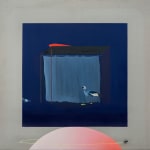

Piers Alsop British , b. 1984
Sleeper, 2020-2021
Oil on canvas.
130 x 130 cm
51 1/8 x 51 1/8 in
51 1/8 x 51 1/8 in
The ascetic rigidity of this composition seems, at first, to be quoting the pared down style of the constructivists. And yet, on closer inspection the abstraction is broken by two...
The ascetic rigidity of this composition seems, at first, to be quoting the pared down style of the constructivists. And yet, on closer inspection the abstraction is broken by two birds facing one another. The austere setting lends itself to a sinister interpretation of the painting's title. In fact, PA says he was looking at Henry Fuseli’s ‘The Nightmare’ a lot whilst working on it.
The pigeon appears to be pecking at nothing whilst the black crowned crane stands over a broken egg and a book titled ‘Pigeon English’ (by Stephen Kelman, in part a response to the murder of Damilola Taylor in south London in 2000). The structure that the crane inhabits still evokes Peckham Library, which was designed by the artist’s late father: the architect Will Alsop.
The scene also echoes, somewhat perversely, the format of the popular subject in Christian art; the annunciation. It is typical of themes that run through Piers Alsop’s work, which tends to fizz between the sincere and the comic. This painting delves further into his interest in the contemporary ‘use’ of art. By parodying art history, he questions the way in which we deal with the sacred in a secular society.
The pigeon appears to be pecking at nothing whilst the black crowned crane stands over a broken egg and a book titled ‘Pigeon English’ (by Stephen Kelman, in part a response to the murder of Damilola Taylor in south London in 2000). The structure that the crane inhabits still evokes Peckham Library, which was designed by the artist’s late father: the architect Will Alsop.
The scene also echoes, somewhat perversely, the format of the popular subject in Christian art; the annunciation. It is typical of themes that run through Piers Alsop’s work, which tends to fizz between the sincere and the comic. This painting delves further into his interest in the contemporary ‘use’ of art. By parodying art history, he questions the way in which we deal with the sacred in a secular society.


